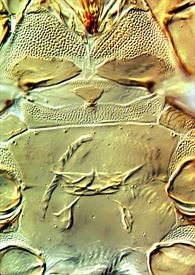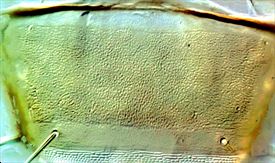
Antenna

Head & pronotum

Meso & metanotum, pelta & tergite II

Thoracic sternites

Male sternite VIII pore plate
Distinguishing features
Both sexes micropterous. Body pale brown to yellow with darker markings medially on tergites; distal antennal segments darker; tube yellow basally, dark brown in distal three-quarters; major setae pale. Head about as long as wide; eyes reduced, directed forwards; maxillary stylets close together medially, retracted almost to eyes; mouth cone rounded; postocular setae long, their apices expanded. Antennae 8-segmented; segment III with 2 sense cones, IV with 3 sense cones; VII and VIII broadly joined. Pronotum lacking sculpture; all 5 pairs of major setae well developed, with apices capitate; basantra absent. Fore tarsal tooth not developed, but inner margin of fore tarsi slightly expanded. Mesopresternum very slender medially, with a pair of small, triangular sclerites laterally; metathoracic sternopleural sutures complete. Fore wing lobe with 2 setae. Metanotum without sculpture; median setae long, expanded at apex. Pelta transverse, bearing 2 large pores; tergites II–VII each with 2 pairs of small wing-retaining setae ; tergal major setae capitate except S2 on VIII and IX; tube shorter than head.
Male similar to female, but fore tarsus with stout tooth; tergite IX with setae S2 similar to S1; sternite VIII fully occupied by pore plate; median sternites without specialised reticulate areas.
Related species
The genus Hoplothrips comprises about 130 species worldwide, of which 7 are recorded from New Zealand. Several of these appear to be endemic to this country, but corticis is from the Northern Hemisphere and orientalis is probably from Asia. H. oudeus can be distinguished from other members of Hoplothrips by the broadly based eighth antennal segment, the five pairs of equally long pronotal major setae, all with the apices broadly capitate, and the pair of large metanotal median setae with capitate apices. It is also unusual in the following conditions: female without a fore tarsal tooth, fore wing with no duplicated cilia, sternite VIII of male almost completely occupied by pore plate, male tergite IX setae S2 as long as S1 with apices capitate.
Biological data
Although presumably fungus-feeding as are other member of Hoplothrips, this species has been collected only from leaf litter.
Distribution data
Although described from New Zealand (ND, TO), a few specimens of what appear to be the same species have been seen from eastern Australia, and these incolude the only known macropterae.
Family name
PHLAEOTHRIPIDAE, PHLAEOTHRIPINAE
Species name
Hoplothrips oudeus Mound & Walker
Original name and synonyms
Hoplothrips oudeus Mound & Walker, 1986: 62
References
Mound LA & Walker AK (1986) Tubulifera (Insecta: Thysanoptera). Fauna of New Zealand 10: 1–140.